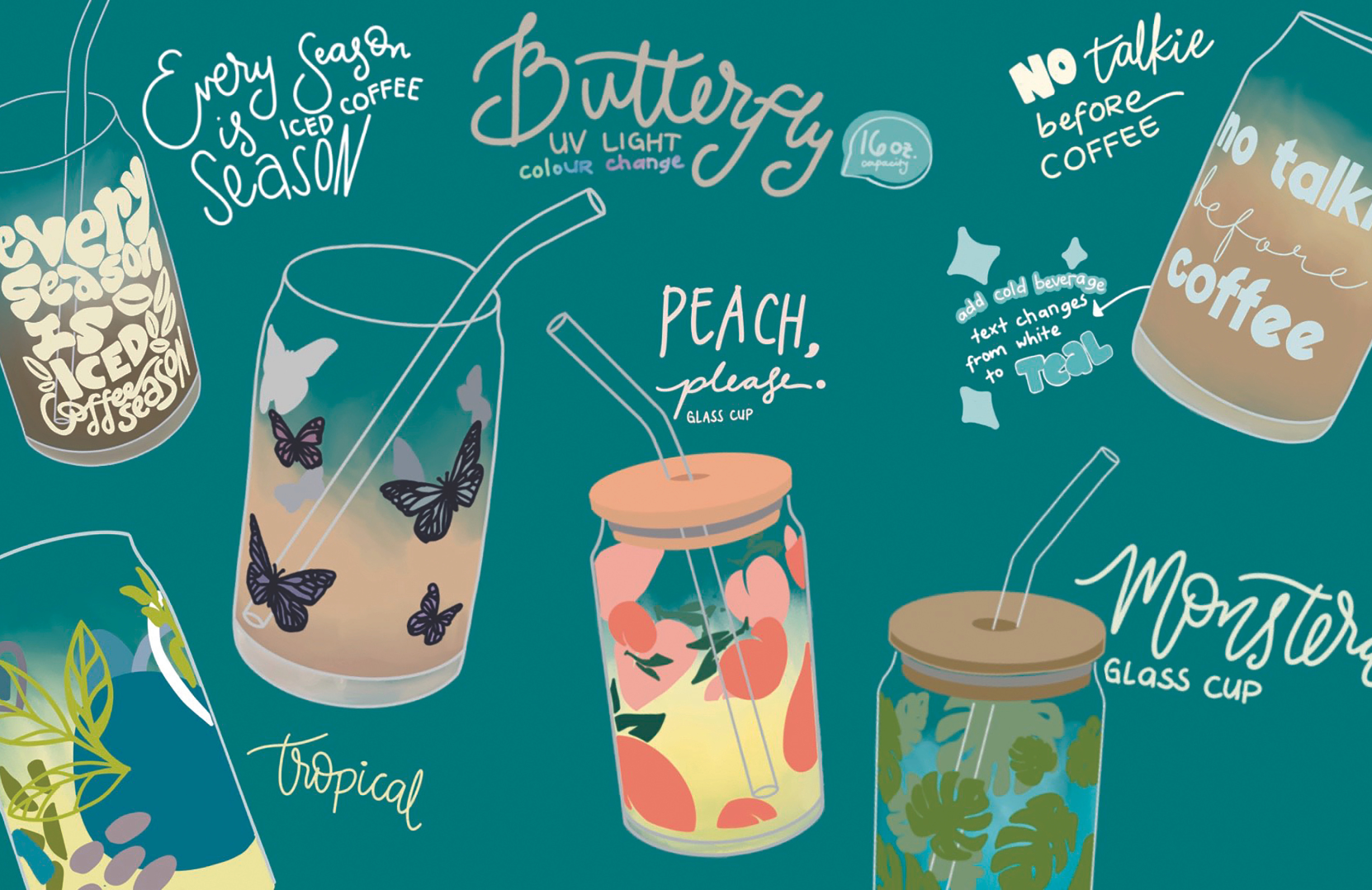Each year, MacEwan University’s design program continues to blossom with new talent and fresh eyes. With new initiatives, opportunities, and a strong sense of community, the design program and its students are on a smooth ride toward a bright future.
Not many students outside of the Fine Arts and Communications faculty may actually know what the design program is about. Design is all around us, all the time, from the software logos on our laptops to every infographic we read on social media. But wait, there’s more!
The design program is rich with diverse class selections that dig deep into several design disciplines. In the program, there are no majors or minors, so students are free to choose their own path depending on their unique interests and passions. The program allows students to take charge of their academic careers, tailoring courses to their goals.
Most of the classes are group-project heavy, allowing students in the program to become familiar with each other quickly. Many classes are four hours long, split into two-hour lectures and two-hour labs, which gives students theoretical knowledge and hands-on experience.
The design program is categorized into four discipline areas, yet they still overlap with one another. These include illustration, visual communication design (VCD), photography/video/motion graphics, and digital experience design (DXD), also called user experience (UX).
In their fourth year, students are required to hand in a capstone project, which is where practicum and passion projects meet. The creative direction is up to the student. Students have the chance to showcase all that they have learned and put their skills toward something they care about.
We spoke with four fourth-year design students to learn more about what MacEwan’s design program has to offer students and dig into the different disciplines that students can specialize in.
Aldricia Chong, co-president of the Design Students’ Organization (DSO), says the design program is all about trying new things, and she encourages students to stay open-minded when it comes to different routes in design. “I really did not know what I really wanted to go into,” Chong explained. “Mainly, I was like, ‘Oh, photography and videography…that seems fun!’ After (taking) a typography class, I’m like, ‘designing books and all that stuff is pretty fun, too!’”
Chong is interested in 3D design, graphic design, motion graphics, and publication, but other students may be focusing on completely different areas of design.
Rochelle Kriewaldt focuses on UX and is currently working with software developers to create a web app for business students, creating wireframes working on the front end of the app. Her and another student were discovered through a class project. “(The project lead) found us through that class by watching our final presentations at the end of the semester, so that was really exciting for us. We were stoked! How cool, because now I’ll actually graduate with ‘product designer’ on my resume, which is the dream.” Kriewaldt is also working on her capstone project, which involves revamping point-of-sale systems that are used in restaurants and bars. This project is very close to her heart, having worked in the service industry throughout high school and university.
From designing a real album cover for jazz group Up and Over Trio in a typography class to designing her own website and brand as a graphic designer, Cynthia Ma is satisfied with the kind of work she’s been able to do through the program and appreciates the versatility of projects. “Design is cool in the fact that you could be doing one thing one week and a different thing the next week,” she claims. Ma enjoys working on mixed media design, which involves printing presses, posters, and the physical aspects of design. Ma has a lot to be proud of when it comes to the designs that she has completed while attending MacEwan. She has a previous degree in social sciences, majoring in psychology, and says it’s very different from what she learns in design. Instead of essays and final exams, she has final projects instead. She appreciates project-based work since she comes from a nine-to-five work background where deadlines and projects are the norm.
The design program is as flexible and diverse as its students. “If you enjoy creating art or you like sciences, I’d say design is the perfect medium because it involves problem-solving, but uses that creative, visual side. Even though not all of the courses are specifically offered to
architecture, urban planning, environmental sciences, and stuff like that, you can still
apply that stuff in your projects and create something,” says Bridgette Crabbe, who is also co-president of the DSO. Crabbe also says she has grown a lot through collaborating with others in the program. “When I started my first year I was very introverted. It was a goal for me to put myself out there because you gotta do that… gotta get a job somehow!”
A common assumption about design is that there are only a few career paths a design graduate can take. “It’s interesting because it seems like there are three avenues for most graduates for design. Either you join an agency, and that’s that highly competitive industry market, and then there’s freelance where you just work for yourself,” Ma explains. “And then there’s working for a large company that has in-house marketing or design components.” However, it’s not so black and white. Graduating with a design degree leaves you with nearly limitless career opportunities. There are some niche jobs, too, like hand-lettering and mural design.
“When I tell people I’m (doing a) Bachelor of Design, they’re always asking me about art and (if) I’m taking art classes and I’m actually not; I’m not taking a single art class,” Kriewaldt confessed. “I definitely always have to explain what I do. My family has no idea what it is that I do. They will one day. I’ll just have to show them what I made.”
Advice for students interested in entering the design program
Ma recommends taking the time in post secondary to explore various options because you never know what may strike your interest. “Design and that kind of creative outlet was something I never thought I could do professionally, academically,” she explained. “Don’t pigeonhole yourself into a certain area just because you’ve never had the chance or opportunity to explore.” Putting all your eggs in one basket isn’t the best strategy when it comes to the design program or any program for that matter. “I love all types of design, and I don’t wanna necessarily put myself in one basket and only do that type of design. I want to do as many different (forms of) design as possible,” she says.
Chong suggests reaching out to fellow classmates for guidance. “The design program is a very open and supportive program. If you don’t know what you’re interested in, you can take a bunch of classes and figure that out,” she advises. “There’s a lot of people that are in the same boat as you. There’s people that will help you and encourage you to try it out.”
Crabbe agrees. “The people that you’re in that program with right now could be your coworkers in the future, so making those connections now may be beneficial.”
The Design Students Organization
The DSO of MacEwan University is a student-run group with the goal of fostering a community of Edmonton-based artists and designers.
The DSO has tons of initiatives that benefit design students and work to knit the creative community of Edmonton together. Chong and Crabbe run the DSO and work to connect students with working professionals in the design industry. “The club has definitely been our baby,” Chong says, “everything has been online for two years, so we really want to bring (speakers and events) back again”.
Becoming co-presidents of the DSO was a huge milestone for both Crabbe and Chong. In their first year at MacEwan, the dynamic duo made it a goal to be a part of the club, and now they’re running the show. “In my first year, I knew of them (the DSO executives), and I was so intimidated by them and thought they were so cool,” Chong reveals. “Now I’m in my fourth year, and I am ‘them,’ and I am ‘them’ with my best friend too, so it’s even better!” Additionally, Crabbe and Chong are women of colour and describe being in an authoritative position in an institution as empowering.
When they’re not working on several projects at once, Crabbe and Chong continue to grow The DSO by hosting several events that foster student growth and overall success for the future.
Design Students Organization Initiatives
The organization hosts monthly mixers with design students, but students from any faculty are welcome to join. These mixers serve as a networking event and encourage students and professionals to build rapport. The organization brings in industry professionals to share their experiences in the field and impart wise counsel on the students.
The Orange Design Conference is another DSO initiative which is like a TedTalk but for all things design. The last one was hosted on April 2 2022, and involved three unique speakers who touched on different disciplines in the design field.
Additionally, the DSO has a discord channel dedicated to posting jobs, volunteer, and internship opportunities for students, and providing a space for individuals to interact freely and support one another.
The DSO sets design students up for success post-graduation by building student-working professional relationships early.
Design is more than drawing and editing photos. Design is present in our everyday lives and helps bridge our way toward an efficient, and better future.
DSO Social Media Handles:
Instagram and Facebook: @dsoyeg
Bridgette Crabbe: @bridgettecrabbe
(Portfolio — bridgettecrabbe.com)
Aldricia Chong: @aldriciachong
(Portfolio — aldriciachong.com)
Students:
Cynthia Ma Portfolio — madebythia.ca
Rochelle Kriewaldt: @sondergraphicstudio





0 Comments